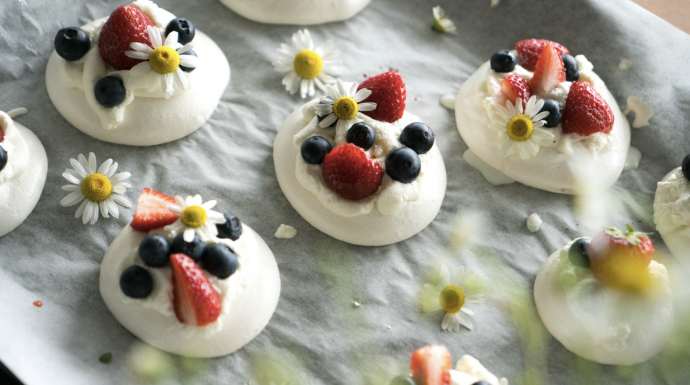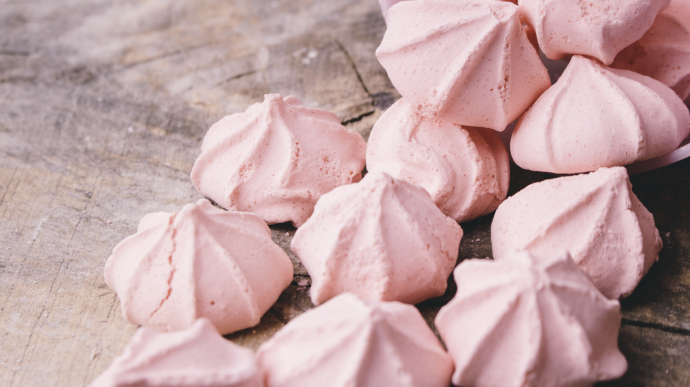Meringues have a reputation for being tricky to make, but once you’ve read our guide you’ll be confidently whisking up big, billowing meringues like a pro! Making meringue doesn’t have to be intimidating. In its basic form, meringue is nothing more than sugar and egg whites. When beaten with a whisk or electric mixer, it incorporates air into the mixture. The air gets trapped, causing the egg whites to get stiff and puff up. Follow these simple tips and tricks for fool-proof meringue every time.
1. Rubbing butter in

If you wish to make pastry, it is essential that the butter is well chilled before you begin to rub it into the flour. Rubbing butter in by hand takes little effort and is the best way of controlling the end result, since using a food mixer for this task can often result in overprocessing.
1. Use only your fingertips to rub the butter into the flour. This little trick prevents the mixture from overheating.
2 for simple pastry, the finished result should have the texture of coarse breadcrumbs.
2. Using ice-cold water

Using cold water, or even ice water, to bind pastry together is a simple way to achieve better results. Ice water prevents the fats in the pastry from breaking down, which would leave the pastry crumbly and difficult to handle when rolling out.
3. Rising in the Refrigerator

Certain baked goods, such as cinnamon rolls, are better served fresh for breakfast, but they are too time-consuming to prepare on the spot. Plan ahead and allow the second rising to happen in the refrigerator overnight. Just be sure to bring the rolls to room temperature before baking as usual.
4. Using butter in danish pastry

Most recipes for danish pastry call for the butter to be rolled out between pieces of parchment paper before incorporating it into the dough. However, this is a sticky and time-consuming process. For a simple, fuss-free result, try cutting well-chilled butter into slices and
Laying them directly onto the pastry.
1. Keep the butter in the refrigerator until it is time to use it to ensure it is well chilled and firm. Cut it into equal-sized slices.
2. Lay the slices of butter evenly on one half of the pastry, making sure you leave a small border all around.
3. Fold the other half of the dough over the butter, pressing the edges together to seal it in.
4 flour the dough well and roll it out into a rectangle 3⁄8in (1cm) thick, before folding and chilling it as required.
5. How to make quick flaky pastry

Making a classic flaky pastry involves a time-consuming process of layering the butter over the dough (see tip 63), then folding, rolling, and chilling it numerous times for the lightest, flakiest result. Although this traditional method makes a fine pastry, when time is short it is possible to adopt this simple and speedy alternative, which produces pleasing results and is a lot less messy, too.
1. Put the butter in the freezer for 30 minutes or until it is semifrozen to allow it to be
Grated easily.
2 gently incorporate the flour into the butter flakes until it is only just combined. This helps retain the texture of the pastry.
6. How to make a chewier meringue

There are times when a crisp meringue is called for, and others when a chewier result is
What is required. To give your meringue a chewier finish, gently fold a teaspoon each of cornstarch and white-wine vinegar into the mixture before cooking.
7. How to clean a bowl for use with egg whites

Whisking egg whites can be a difficult process—even the smallest amount of shell or egg yolk in the bowl can cause the whites to resist your efforts to bring them to soft or stiff peaks. For perfect results every time, go through the following procedure. First of all, ensure that the bowl is perfectly clean, free of any greasy or dusty residue. Next, rub the inside of the bowl with the cut side of a lemon or a little white vinegar, then wipe it dry with a paper towel before beginning to whisk the egg whites.
Citrus layer to avoid waste, cut just a little off the end of a lemon—enough that the flesh is exposed— rather than using a whole half.
8. How to get whiter meringues

The secret to producing meringues of remarkable snowy whiteness, with a crisp exterior and a hollow interior, is a long, slow cooking time. An extremely low oven heat helps (the ideal temperature being around 240ºf/120ºc). If your oven doesn’t go low enough, consider using a wooden spoon to prop the door open slightly.
Delicious meringues
A meringue is ready when it is crisp on the outside and sounds hollow when tapped gently on the underside.
9. Avoid cracking

Meringues are fragile goods and can crack easily once cooked, which can be very frustrating because they take so long to bake. Meringues tend to crack because they are susceptible to sudden changes in temperature. Prevent this from occurring by turning off the oven when they are ready and leaving them to cool inside.
Cooling meringues once they are cool to the touch, place the meringues on a rack and allow them to cool completely before storing.










